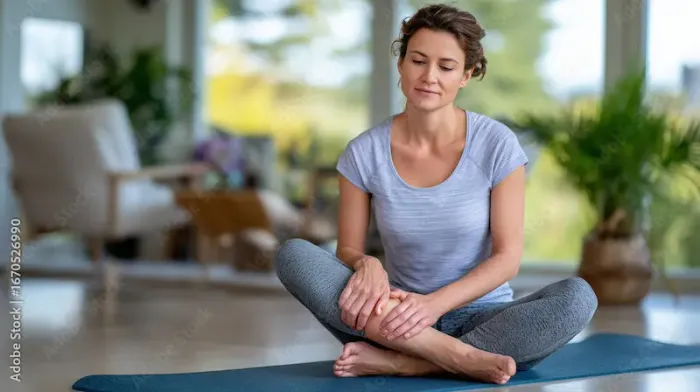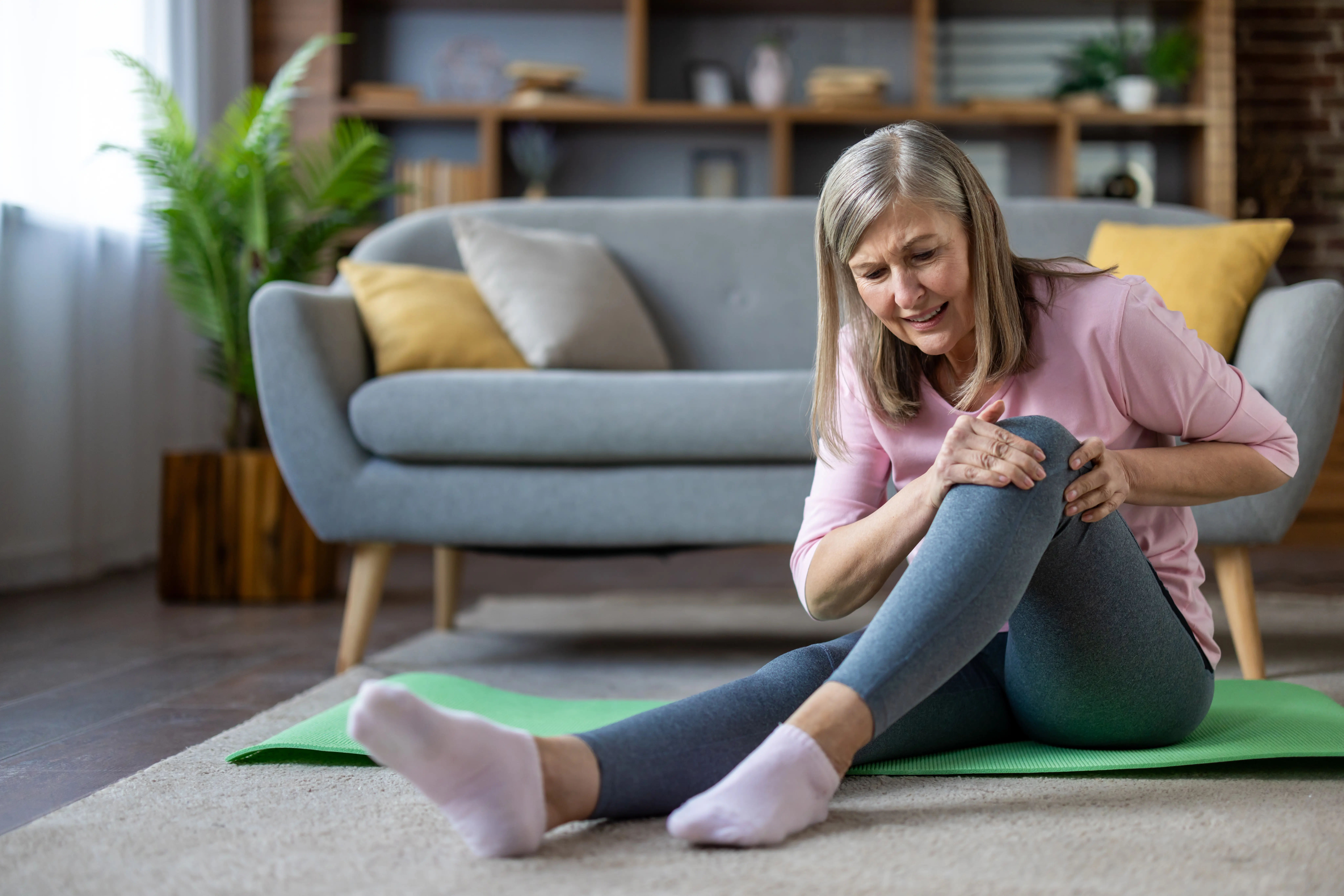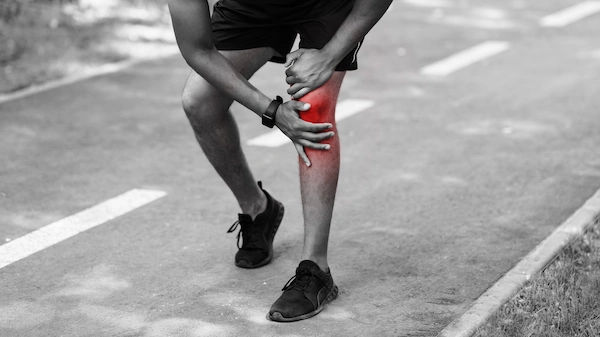Yoga for Knee Pain Relief: A Complete Guide
Gentle yoga for knee pain relief. Find safe poses, modifications, and routines to strengthen muscles around the knee and reduce discomfort naturally.


Introduction
Knee pain can creep into everything—walking the stairs, getting out of a chair, even a peaceful yoga class. The good news? With the right approach, yoga can be a powerful, knee-friendly way to ease pain, build strength, and move with more confidence. This guide brings together practical advice, science-backed insights, and step-by-step strategies to help you practice yoga safely when your knee hurts.
You’ll learn how to recognize common causes of knee pain, the benefits and limits of yoga, and the essential alignment habits that protect your joints. We’ll walk through a gentle warm-up, the best knee-friendly yoga poses, smart modifications, and two simple routines you can do at home. You’ll also get troubleshooting tips for flare-ups, everyday habits that affect your knees, and guidance on when to seek medical help. Whether you’re managing osteoarthritis, runner’s knee, or general soreness, this comprehensive guide will help you tailor yoga to your body and your life.
Why Your Knee Hurts?: Common Causes and Clues
Knee pain has many sources, and knowing the likely cause helps you choose the right yoga modifications. The most common cause in adults over 50 is osteoarthritis (OA), where cartilage thins and the joint becomes stiff and achy. Pain often eases with gentle movement and returns after prolonged activity; morning stiffness that improves within 30 minutes is typical. Regular strengthening and range-of-motion exercise are core parts of OA management and can ease pain over time.
In active adults and younger people, patellofemoral pain syndrome (PFPS)—often called runner’s knee—presents as aching around or behind the kneecap, worse with stairs, squats, or sitting for long periods. The driver is often a strength/control imbalance higher up the chain (hips and core), leading the knee to track inward. Knee-friendly yoga that strengthens hip abductors and external rotators can reduce this pain pattern.
Meniscal irritation or small tears often follow a twist or deep squat. You may feel sharp joint-line pain, catching or clicking, and discomfort with deep flexion. Many degenerative meniscal tears are managed conservatively with progressive strengthening and activity modification; avoid deep kneeling and end-range flexion until symptoms settle.
Tendinopathy (like patellar tendon) or bursitis (pes anserine) causes localized tenderness—often aggravated by jumping or rapid increases in load. Modify impact and range, and use slow, controlled strengthening.
Red flags that need prompt medical evaluation include a hot, swollen joint with fever; a knee that “gives way” repeatedly; true locking (cannot fully bend/straighten); severe pain after trauma; or pain that persists or worsens despite rest. If you notice these, consult a doctor online with Apollo 24|7 for further evaluation. When in doubt, a professional assessment helps you safely tailor yoga to your knee pain.
Consult a Top General Physician
Can Yoga Help Knee Pain? What the Science Says (and Doesn’t)
Gentle, well-structured yoga can reduce knee pain and improve function by blending low-impact strength, mobility, and balance training with breathwork that calms the nervous system. For knee osteoarthritis, guidelines emphasize exercise for pain relief and better mobility; yoga is a user-friendly way to meet those goals. Several reviews report that yoga can modestly reduce pain and improve function in OA and chronic musculoskeletal pain, especially when programs emphasize alignment, slow progression, and regular practice.
Mechanisms include: improved quadriceps and hip strength (better patellar tracking), increased joint range, better proprioception and balance (reducing aggravating missteps), and central pain modulation through relaxation and breathing. Styles like Hatha, Iyengar, restorative, and chair yoga are often recommended for knee pain because they’re slower, use props, and allow precise alignment—ideal for a knee-friendly yoga sequence.
Here’s what yoga cannot do: it won’t “repair” a torn ligament or rebuild cartilage. It’s not a quick fix for severe instability or acute trauma. And if poses are done with poor alignment (for example, knees caving inward in squats or twists loaded through a bent knee), yoga can irritate symptoms. That’s why knee-safe alignment and modifications are essential.
The most successful programs meet you where you are: short sessions, steady breathing, controlled ranges, and gradual loading. If you’re dealing with a runner's knee, focus on hip-strengthening poses; for meniscus irritation, avoid deep flexion and pivoting. For OA knee, aim for 2–4 sessions per week incorporating strength, mobility, and breath. If your condition does not improve after trying these methods, book a physical visit to a doctor with Apollo 24|7.
Safety First: When to Pause, Modify, or See a Doctor
Knowing when to push and when to pause keeps yoga helpful, not harmful. Stop a pose if you feel sharp, catching pain; a sense of giving way; or pain that lingers beyond 24–48 hours after practice. Swelling, warmth, or redness signal over-irritation—back off range and reduce load. Pain at a tolerable 2–3/10 that eases as you move and is gone by the next day can be acceptable as your knee adapts; intense pain (5+/10), buckling, or true locking is not.
To modify on sore days:
• Shorten ranges: half squats instead of deep bends; keep the front knee at 30–45° in lunges.
• Offload: use a wall, chair, or blocks for support; place a folded blanket under knees when kneeling or replace kneeling with supine variations.
• Change the plane: practice seated or reclined versions of standing poses to reduce joint load.
• Pace: slow, smooth transitions; avoid quick pivots or deep knee twists.
Seek medical care if you have: a hot, swollen knee with fever; inability to bear weight; trauma with severe pain; symptoms persisting beyond two weeks; or progressive worsening. Consult a doctor online with Apollo 24|7 for timely guidance. If labs are relevant—e.g., vitamin D if you have diffuse bone/joint aches or HbA1c if diabetes may be contributing to inflammation—Apollo 24|7 offers a convenient home collection for tests like vitamin D or HbA1c.
Yoga is safest when integrated with clinician advice, especially if you have OA, previous knee surgery, or suspected meniscus or ligament injury. Consider starting with a few sessions guided by a yoga teacher experienced in joint-safe practice or an allied health professional familiar with yoga.
Knee-Safe Alignment and a 10-Minute Warm-Up
Alignment principles that protect your knee:
• Knee-over-second-toe: In squats, lunges, and standing poses, track the kneecap toward the second or third toe—no collapsing inward (valgus) or rolling outward. This protects the patellofemoral joint and meniscus.
• Control rotation at the hip: Most “knee” problems are “hip control” problems. Lightly engage glutes to prevent the thigh from turning inward during bends and weight shifts.
• Soft knee, strong foot: Avoid hyperextending the knee in standing poses. Root the tripod of the foot (big toe mound, little toe mound, heel) to stabilize the chain.
• Spines and lines: Neutral pelvis and tall spine help the knee track well. Don’t chase depth; chase control.
Props that make yoga knee-friendly:
• Blocks under hands in lunges or Half Splits reduce leverage on the knee.
• Straps for hamstring stretches or hand-to-big-toe pose to avoid yanking on the joint.
• Blankets under knees for cushioning; a chair or wall for balance.
A 10-minute warm-up for knee pain relief:
1) Breath + gentle ankle pumps (1 minute): Supine, inhale 4, exhale 6; pump ankles to get fluid moving.
2) Heel slides (1 minute): Supine, slide heel toward sit bone, then extend gently, 8–10 each side.
3) Short Arc Quad (1 minute): Small pillow under knee; straighten knee to tighten thigh, hold 3 seconds; 10 reps.
4) Hip abductor activation (2 minutes): Side-lying clamshells or standing “monster walks” with a light band just above knees for 10–15 controlled reps.
5) Mini Chair at wall (2 minutes): Back to wall, slide to 30–45° knee bend, hold 5 breaths; 3 reps.
6) Supported Low Lunge (3 minutes): Hands on blocks, short stance, gently glide forward and back; 5–8 slow reps each side, keeping knee over second toe.
This warm-up lubricates the joint, primes key muscles, and sets alignment—ideal before a knee-friendly yoga sequence.
Best Yoga Poses for Knee Pain Relief and Support
Gentle strengthening
• Supported Chair (Utkatasana, short range): Stand with your back to a wall or hold a chair. Sit back slightly, keep knees over second toes, stop at 30–45° bend. Hold 5 breaths, 3–5 rounds. Builds quadriceps for patellar support—a cornerstone for patellofemoral pain yoga exercises .
• Bridge Pose (Setu Bandha Sarvangasana): Supine, feet hip-width, press through heels to lift hips. Keep knees tracking forward. Hold 5–8 breaths, 3 rounds. Strengthens glutes/hamstrings to unload the knee.
• Locust (Salabhasana, low): Prone, lift chest and legs slightly, reach through toes. Keep glutes lightly engaged. 3–4 breaths, 3 rounds. Improves posterior chain support.
Mobility/flexibility
• Hamstring Strap Stretch (Supta Padangusthasana A, neutral): Supine, strap around mid-foot, keep pelvis neutral, micro-bend the knee if needed. 5–8 breaths each side. Useful for knee pain linked to tight posterior chain.
• Low Lunge (Anjaneyasana, short stance): Back knee padded or lifted; hands on blocks; glide gently. Emphasize hip flexor length without collapsing into the front knee.
• Supported Bound Angle (Supta Baddha Konasana): Reclined with bolsters/blocks under thighs so knees are comfortable. Encourages gentle groin opening without knee strain; great for gentle yoga for seniors with knee pain.
Balance and control
• Mountain (Tadasana) with Band: Light loop above knees; stand tall, press knees outward slightly to align over toes; feel glute med fire. Hold 5 breaths, 3 rounds.
• Short-stance Warrior 2 (Virabhadrasana II): Shorten stance to protect knee, front knee over second toe, weight evenly through feet, avoid collapsing into inner arch. Build endurance with 20–30-second holds.
Unique tip: In all standing poses, think “rotate the thigh outward slightly from the hip” to align the kneecap—subtle hip external rotation can immediately reduce pressure around the kneecap.
Build Your Knee-Friendly Yoga Routine (20–30 Minutes)
Beginner sequence (approx. 20 minutes)
• Warm-up (10 minutes as above)
• Supported Chair: 3 rounds of 5 breaths
• Bridge: 3 rounds of 5–8 breaths
• Hamstring Strap Stretch: 5–8 breaths each side
• Supported Bound Angle: 1–2 minutes with relaxed breathing
• Final breathwork: 2 minutes of 4-6 breathing (inhale 4, exhale 6)
Low-impact flow (approx. 25–30 minutes)
• Warm-up (5–7 minutes)
• Short-stance Warrior 2: 20–30 seconds each side, 2 rounds
• Low Lunge with blocks: 5 slow glides each side
• Locust (low): 3 rounds of 3–4 breaths
• Bridge: 3 rounds
• Mountain with Band: 3 rounds of 5 breaths
• Reclined Hand-to-Big-Toe (strap): 5–8 breaths each side
• Savasana with gentle breath: 2–3 minutes
Micro-strength add-ons
• VMO cueing: Place a small ball or folded towel between knees in Bridge; gently squeeze as you lift to engage medial quad—great for yoga to strengthen quadriceps for knee support.
• Glute med activation: Lateral weight shifts in Mountain with a band; feel outer-hip engagement, then carry that control into Warrior 2.
Progression ideas
• Increase holds by 5–10 seconds weekly if pain stays ≤3/10 and resolves by next day.
• Add another day per week once you tolerate two sessions without next-day soreness.
• Combine this with 10–20 minutes of walking or cycling on alternate days for comprehensive knee rehab.
Lifestyle, Recovery, and Troubleshooting Flares
Everyday habits matter.
• Footwear: Supportive shoes with a stable heel counter reduce knee valgus during daily steps.
• Stairs: Use a handrail; step up with the stronger leg, down with the more comfortable leg to reduce pain.
• Sitting: Avoid long static postures; stand and move every 30–60 minutes. When rising, hinge at hips and drive through heels to spare the knee.
• Workstation: Neutral hip-knee-ankle alignment; feet flat, hips slightly above knees.
Managing flares with PEACE & LOVE
• PEACE (Protect, Elevate, Avoid anti-inflammatories early, Compression, Education) and LOVE (Load, Optimism, Vascularization, Exercise) emphasize relative rest first, then gradual reloading—useful for minor soft-tissue flares from overdoing it [11].
• On flare days: shorten ranges, use more support, prioritize breath and gentle circulation (e.g., ankle pumps, easy walking).
Progression and tracking
• Frequency: Aim for 2–4 yoga sessions per week for 8–12 weeks.
• Intensity: Keep discomfort ≤3/10 and gone by the next day.
• Tracking: Use a simple 0–10 pain scale and note function markers (e.g., stairs, sitting tolerance). Consider the KOOS (Knee injury and Osteoarthritis Outcome Score) as a free patient-reported measure.
When to seek help?
If you notice swelling, instability, or pain that’s escalating, consult a doctor online with Apollo 24|7. If appropriate, ask about vitamin D or HbA1c testing; Apollo 24|7 offers a convenient home collection for these labs.
Conclusion
Knee pain doesn’t have to sideline your movement—or your yoga. With careful alignment, smart modifications, and a steady progression, yoga can become a reliable tool to ease pain, stabilize the joint, and restore confidence in daily life. Focus on the foundations: track the knee over the second toe, control rotation from the hip, use props generously, and move at a pace that lets your breath stay calm and even. Choose knee-friendly poses that build quadriceps and glute strength, balance flexibility with stability, and avoid deep kneeling or twisting through a bent knee.
Consistency matters more than intensity. Aim for two to four short sessions per week, layering a 10-minute warm-up onto a simple routine of Supported Chair, Bridge, targeted stretches, and mindful balance work. Keep a light log of pain and function so you can celebrate progress and adjust when needed.
If your knee pain persists beyond two weeks, swells, or feels unstable, consult a doctor online with Apollo 24|7 for tailored guidance. And if labs could be relevant for your overall joint health—such as vitamin D or HbA1c—Apollo 24|7 offers a convenient home collection. The path to stronger, happier knees is not about pushing harder; it’s about moving smarter. Start where you are, breathe, and let your yoga practice support you—step by step.
Consult a Top General Physician
Consult a Top General Physician

Dr. Rajib Ghose
General Physician/ Internal Medicine Specialist
25 Years • MBBS
East Midnapore
VIVEKANANDA SEBA SADAN, East Midnapore

Dr. Vishal Kumar H
General Physician/ Internal Medicine Specialist
8 Years • MBBS, master class in critical care medicine, Advanced Post Graduate Diploma in Non Invasive Cardiology, certificate course in Cardiovascular Disease & Stroke, Certificate course in Common Mental Disorder
Bengaluru
Apollo Clinic, Basavanagudi, Bengaluru

Dr. Tapabrata Ray
General Physician/ Internal Medicine Specialist
4 Years • MBBS,DGM,CPMeC,ACMDC
Kolkata
MCR SUPER SPECIALITY POLY CLINIC & PATHOLOGY, Kolkata
Dr. Paras Gangwal
General Physician/ Internal Medicine Specialist
28 Years • MBBS,MD General Medicine
Delhi
Dr Paras Gangwal Clinic, Delhi

Dr. Harshendra Jaiswal
General Physician/ Internal Medicine Specialist
12 Years • MBBS , MD (General medicine)
Kolkata
108 DHANA DHANVANTARI Clinic, Kolkata
(25+ Patients)
Consult a Top General Physician

Dr. Rajib Ghose
General Physician/ Internal Medicine Specialist
25 Years • MBBS
East Midnapore
VIVEKANANDA SEBA SADAN, East Midnapore

Dr. Vishal Kumar H
General Physician/ Internal Medicine Specialist
8 Years • MBBS, master class in critical care medicine, Advanced Post Graduate Diploma in Non Invasive Cardiology, certificate course in Cardiovascular Disease & Stroke, Certificate course in Common Mental Disorder
Bengaluru
Apollo Clinic, Basavanagudi, Bengaluru

Dr. Tapabrata Ray
General Physician/ Internal Medicine Specialist
4 Years • MBBS,DGM,CPMeC,ACMDC
Kolkata
MCR SUPER SPECIALITY POLY CLINIC & PATHOLOGY, Kolkata
Dr. Paras Gangwal
General Physician/ Internal Medicine Specialist
28 Years • MBBS,MD General Medicine
Delhi
Dr Paras Gangwal Clinic, Delhi

Dr. Harshendra Jaiswal
General Physician/ Internal Medicine Specialist
12 Years • MBBS , MD (General medicine)
Kolkata
108 DHANA DHANVANTARI Clinic, Kolkata
(25+ Patients)
More articles from Knee pain
Frequently Asked Questions
1) Is yoga good for osteoarthritis of the knee?
Yes. Gentle, knee-friendly yoga can reduce pain and improve function in OA, especially when it emphasizes strength, mobility, and alignment. Start with a knee-friendly yoga sequence 2–4 times per week and progress gradually [2][7][9].
2) What yoga poses should I avoid with knee pain?
Avoid or heavily modify deep kneeling (Hero), Full Lotus, deep squats, and twisting through a bent knee. Keep knee-over-second-toe alignment and use props to reduce strain [1][5][6].
3) Can yoga help runner’s knee (patellofemoral pain)?
Yes—particularly poses that strengthen hips and quads and improve control, like Supported Chair, Bridge, and short-stance Warrior 2. Avoid knees caving inward and add hamstring and hip flexor stretches [1][4][5].
4) How often should I do yoga for knee pain relief?
Aim for 2–4 sessions per week, 20–30 minutes each. Keep discomfort ≤3/10 and gone by the next day. If your condition does not improve after several weeks, book a visit with Apollo 24|7.
5) Do I need props for knee-friendly yoga?
Props are highly recommended. Blocks, straps, a chair, and a folded blanket make poses more accessible, improve alignment, and reduce knee stress—key for beginner yoga for knee rehabilitation.

.webp)

